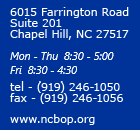Pharmacy Practice FAQsAUTOMATED DISPENSING DEVICES
Q: May an automated dispensing device be used as an “emergency kit”? A: Yes. Board Rule .1419 allows automated dispensing devices to be placed in health-care facilities that hold a pharmacy permit. That rule also notes that operation of an automated dispensing device that is used solely as an Auxiliary Medication Inventory in the health-care facility is governed by Board Rule .1414(d). (Operation of automated dispensing device used for patient profile dispensing in a health-care facility is governed by Board Rule .1419). Board Rule .1414(d) defines an “auxiliary medication inventory” as an “emergency kit”, “ancillary drug cabinet,” or “patient care unit medication inventor[y].” In consultation with medical staff at the facility, a list of drugs and devices must be developed that will be stocked in an auxiliary medication inventory. Such drugs and devices may only be ones required to meet the immediate therapeutic needs of patients, and that are not available from the facility’s pharmacy in a sufficient time to prevent prolonged discomfort or risk of harm to patients. The pharmacist-manager and pharmacy must develop and implement policies and procedures to ensure that only those individuals authorized to administer medications under North Carolina law can access the auxiliary medication inventory. Amounts of medications and devices contained in these inventories must be limited to an amount sufficient to meet the immediate therapeutic needs of patients. All medications and devices contained in an auxiliary medication inventory must be labeled with the name, strength, lot number, manufacturer, and expiration. Each auxiliary medication inventory must have attached a list of all drugs and devices that contains the name, strength, and quantity of each. The pharmacist-manager must also ensure that inventories of all auxiliary medication inventories are reviewed on a schedule set by the health care facility pharmacy’s policies to ensure the purity, potency, and integrity of the drugs and devices contained within. A perpetual inventory must be maintained for all controlled substances transferred to an automated dispensing device used as an auxiliary medication inventory. Further, if controlled substance are contained in the device, it must also comply with 10A NCAC 26E.0408 , which allows skilled nursing facilities, intermediate care facilities, and combination facilities licensed by the Department of Health and Human Services to have a controlled substance emergency kit. A controlled substance emergency kit, whether an automated dispensing device or another implementation, can contain no more than seven (7) controlled (II-V) drug entities, as determined by the medical staff and as approved by the pharmaceutical service committee. Controlled substances for emergency use shall be obtained through purchase orders from the licensed pharmacist who regularly provides medications to the facility. If CIIs are purchased, DEA order forms must be used. The controlled substances must be provided in unit-dose form. “A facility shall not be permitted to possess more than 5 doses of each controlled substance entity for each 50 licensed beds or fraction thereof.” Any emergency kit containing controlled substances must be locked and stored with access limited to authorized personnel. Only those designated by the director of the facility shall have access to these controlled-substance-containing emergency kits. The facility must be registered with the DEA, or have received an exemption, to use controlled substances in this manner, as would be required for any other use.
Q: May a pharmacy that services a nursing home install an automated dispensing device to dispense controlled substances at the nursing home? A: Yes. Federal Drug Enforcement Administration rules – 21 CFR § 1301.17(c) and § 1301.27 – allow, where state law permits, a retail pharmacy to obtain a DEA registration for, and to install, an automated dispensing system at a long term care facility. These systems allow dispensing of single dosage controlled-substance units and can mitigate the problem of excess controlled-substance stocks and disposal. Under Board rules, an automated dispensing device may only be installed at a facility holding a pharmacy permit. A limited-service permit may be obtained for the installation of automated dispensing systems in a long-term care facility.
|

